Analysis and Assessment of the Usefulness of Recycled Plastic Materials for the Production of Airfield Geocell
Abstract
:1. Introduction
1.1. Overview
- Rigid pavements;
- Flexible pavements;
- Semi-rigid pavements;
- Natural pavements.
- Runway shoulders;
- Runway end safety areas (RESA).
1.2. Overview of Existing Solutions
1.3. Recycled Plastic Material as Airfield Geocell Material
- High-pressure polyethylene–low density (e.g., LDPE);
- Low-pressure polyethylene–high density (e.g., HDPE).
1.4. Injection Method of Forming Finished Products from Recycled Plastic Waste
2. Materials and Methods
2.1. Static Flexural of Plastic Samples
2.2. Static Tensile of Plastic Samples
2.3. Compression Test of Airfield Geocell Made of Recycled Plastic Materials
- Compressive strength during short-term compression, σmr [kPa];
- Compressive strain determined from the displacement of the movable compressive plate relative to the base plate for the σmr, εmr [%];
- Compressive strain determined by a video-extensometer for the σmr, εmr,ve [%].
2.4. Determination of the Resistance of Plastic Samples to Consumables
2.5. Method of Installation of Airfield Geocells on Natural Airfield Pavement
2.6. Tests on the Load Capacity of the Natural Airfield Pavement Reinforced with an Airfield Geocell Made of Recycled Plastic Material
3. Results
3.1. Static Flexural of Plastic Samples
| Sample Number | Ef 1 [MPa] | Efśr [MPa] | S(Ef) 2 [MPa] | mEf 3 [MPa] | EfMNK 4 [MPa] | EfMNKśr [MPa] | S(EfMNK) 5 [MPa] | mEfMNK 6 [MPa] |
|---|---|---|---|---|---|---|---|---|
| 1 | 946 | 947 | 14.8 | 935 < mEf < 959 | 940 | 944 | 14.1 | 932 < mEfMNK < 956 |
| 2 | 935 | 937 | ||||||
| 3 | 926 | 925 | ||||||
| 4 | 938 | 938 | ||||||
| 5 | 953 | 948 | ||||||
| 6 | 973 | 973 | ||||||
| 7 | 945 | 940 | ||||||
| 8 | 959 | 952 |
3.2. Static Tensile of Plastic Samples
3.3. Compression Test of Airfield Geocell Made of Recycled Plastic Materials
3.4. Determination of the Resistance of Plastic Samples to Consumables
3.5. Tests on the Load Capacity of the Natural Airfield Pavement Reinforced with an Airfield Geocell Made of Recycled Plastic Material
4. Discussion
5. Conclusions
Author Contributions
Funding
Institutional Review Board Statement
Informed Consent Statement
Data Availability Statement
Conflicts of Interest
References
- Wesołowski, M.; Poświata, A. Airfield pavements as an element of critical infrastructure in the airport safety management process. Commun. Overv. 2017, 11, 22–26. [Google Scholar] [CrossRef]
- Nita, P. Construction and Maintenance of Airport Pavements, 2nd ed.; Publications of Communication and Communications: Warsaw, Poland, 2008; p. 19. [Google Scholar]
- International Civil Aviation Organization. Annex 14 to the Convention on International Civil Aviation, 7th ed.; International Civil Aviation Organization: Montreal, QC, Canada, 2016; Volume 1. [Google Scholar]
- Standard PN-S-02202: 1998 Roads—Earthworks—Specifications and Testing; PKN: Warsaw, Poland, 1998.
- Standard NO-17-A503:2017 Airfield Pavements. Natural Airfield Pavements. Load Bearing Capacity Tests; MON: Warsaw, Poland, 2017.
- Available online: http://www.planecrashinfo.com (accessed on 21 May 2021).
- Wesołowski, M.; Kowalska, D.; Kowalewska, A. Geocell reinforcement in natural airfield pavement structure in the aspect of the safety of conducted flight operations. In Proceedings of the 29th European Safety and Reliability Conference, Hannover, Germany, 22–26 September 2019; Beer, M., Zio, E., Eds.; Research Publishing: Singapore, 2019. [Google Scholar] [CrossRef]
- Standard PN-EN ISO 10318:2007 Geosynthetics—Terms and Definitions; PKN: Warsaw, Poland, 2007.
- Zhao, M.; Zhang, L.; Zou, X.; Zhao, H. Research progress in two-direction composite foundation formed by geocell reinforced mattress and gravel piles. Chin. J. Highw. Transp. 2009, 22, 1–10. [Google Scholar]
- ASTM D 4439-00 Standard Terminology for Geosynthetics; ASTM: West Conshohocken, PA, USA, 2020.
- Groenler, J.; Monlux, S.; Vachowski, B. Geosynthetics for Trails in Wet Areas, Missoula; United States Department of Agriculture: Washington, DC, USA, 2008.
- Koerner, R.M. Design with Geosynthetics, 6th ed.; Xlibris: Bloomington, IA, USA, 2012; Volume 1. [Google Scholar]
- Presto GeoSystem. Available online: https://www.prestogeo.com (accessed on 21 May 2021).
- Guo, J.; Han, J.; Schrock, S.D.; Parsons, R.L. Field evaluation of vegetation growth in geocell-reinforced unpaved shoulders. Geotext. Geomembr. 2015, 43, 403–411. [Google Scholar] [CrossRef]
- Han, J.; Thakur, J.K.; Parsons, R.L.; Pokharel, S.K.; Leshchinsky, D.; Yang, X. A summary of research on geocell-reinforced base courses. In Proceedings of the 2013 Design and Practice of Geosynthetic-Reinfoced Soil Structures, Bologna, Italy, 14–16 October 2013. [Google Scholar] [CrossRef]
- Kief, O.; Schary, Y.; Pokharel, S. High-modulus geocells for sustainable highway infrastructure. Indian Geoetchnical J. 2015, 45, 289–400. [Google Scholar] [CrossRef]
- Novus HM. Available online: https://www.novus-hm.com (accessed on 25 May 2021).
- PERFO. Available online: http://www.perfo.co.uk (accessed on 25 May 2021).
- Aviation Overview. Available online: www.plar.pl (accessed on 25 May 2021).
- Osiecka, E. Building Materials, Plastics, 1st ed.; University of Warsaw University of Technology: Warsaw, Poland, 2005. [Google Scholar]
- Wagner, A.H.; Yu, J.S.; Kalyon, D.M. Injection molding of engineering plastics. Adv. Polym. Technol. 1989, 9, 17–32. [Google Scholar] [CrossRef]
- Wroclaw University of Technology. Available online: www.tworzywa.pwr.wroc.pl (accessed on 27 May 2021).
- Gruin, I.; Ryszkowska, J.; Markiewicz, B. Polymeric Materials, 1st ed.; University of Warsaw University of Technology: Warsaw, Poland, 1996. [Google Scholar]
- Peacock, A.J. Handbook of Polyethylene. Structures, Properties and Applications; CRC Press: Boca Raton, FL, USA, 2000. [Google Scholar]
- Malinowski, R.; Łubkowski, D. Effect of selected injection process parameters on polypropylene physicochemical properties. Chemist 2009, 62, 425–430. [Google Scholar]
- Kashyap, S.; Datta, D. Process parameter optimization of plastic injection molding: A review. Int. J. Plast. Technol. 2015, 19, 1–18. [Google Scholar] [CrossRef]
- Iwko, J. Polymer plastic injection technology. Guide of the plastics processor. Poradnik Przetwórcy Tworzyw Sztucznych 2010, 40–42. [Google Scholar]
- Szymański, S. Plastics Processing; Gdansk University of Technology: Gdansk, Poland, 2012. [Google Scholar]
- Standard PN-EN ISO 178:2019-06 Plastics—Determination of Flexural Properties; PKN: Warsaw, Poland, 2019.
- Lisiecki, J.; Baran, M. Report on the Static Bending Test of Plastic Samples; Air Force Institute of Technology: Warsaw, Poland, 2020. [Google Scholar]
- Standard PN-EN ISO 527-1:2020-01 Plastics—Determination of Tensile Properties—Part 1: General Principles; PKN: Warsaw, Poland, 2020.
- Baran, M.; Lisiecki, J.; Nowakowski, D. Report on the Static Tensile Testing of Plastic Samples; Air Force Institute of Technology: Warsaw, Poland, 2020. [Google Scholar]
- Standard PN-EN ISO 25619-2:2015-11 Geosynthetics—Determination of Compression Behaviour—Part. 2: Determination of Short-Term Compression Behaviour; PKN: Warsaw, Poland, 2015.
- Lisiecki, J.; Baran, M. Raport z Badania Ściskania Krat Lotniskowych z Tworzywa Sztucznego; Air Force Institute of Technology: Warsaw, Poland, 2020. [Google Scholar]
- Standard NO-17-A500:2016 Airfield and Road Pavements—Road Capacity Testing; PKN: Warsaw, Poland, 2016.
- Wesołowski, M.; Blacha, K. The impact of load bearing capacity of airfield pavement structures on the air traffic safety. In Proceedings of the Environmental Engineering 10th International Conference, Vilnius, Lithuania, 27–28 April 2017. [Google Scholar] [CrossRef]
- Wesołowski, M.; Blacha, K.; Iwanowski, P. Analysis of load bearing capacity of cement concrete airfield pavement’s construction in relation to its’ changes of physico-mechanical parameters. IOP Conf. Ser. Mater. Sci. Eng. 2019, 603. [Google Scholar] [CrossRef] [Green Version]
- Rasol, M.; Perez-Gracia, V.; Fernandes, F.; Pais, J.C.; Solla, M.; Santos, C.R. NDT assessment of rigid pavement damages with ground penetrating radar: Laboratory and field tests. Int. J. Pavement Eng. 2020, 20. [Google Scholar] [CrossRef]
- Wesołowski, M.; Pietruszewski, P.; Iwanowski, P. Analysis of natural airfield pavement load-bearing capacity in the aspect of air operation safety. In Proceedings of the 29th European Safety and Reliability Conference, Hannover, Germany, 22–26 September 2019; Beer, M., Zio, E., Eds.; Research Publishing: Singapore, 2019. [Google Scholar] [CrossRef]
- Standard PN-EN ISO 1133-1:2011 Plastics—Determination of the Melt Mass-Flow Rate (MFR) and Melt Volume-Flow Rate (MVR) of Thermoplastics—Part 1: Standard Method; PKN: Warsaw, Poland, 2011.
- Standard PN-EN ISO 1183-1:2019-05 Plastics—Methods for Determining the Density of Non-Cellular Plastics—Part 1: Immersion Method, Liquid Pycnometer Method and Titration Method; PKN: Warsaw, Poland, 2019.
- Standard PN-EN ISO 527-2:+A1:2019-08 Plastics—Determination of Tensile Properties—Part 2: Test Conditions for Moulding and Extrusion Plastics; PKN: Warsaw, Poland, 2019.
- Standard ISO 16770:2004 Plastics—Determination of Environmental Stress Cracking (ESC) of Polyethylene—Full-Notch Creep Test (FNCT); ISO: Geneva, Switzerland, 2004.
- Standard PN-EN ISO 179-2:2020-12 Plastics—Determination of Charpy Impact Properties—Part 2: Instrumented Impact Test; PKN: Warsaw, Poland, 2020.
- Standard PN-EN ISO 868:2005 Plastics and Ebonite—Determination of Indentation Hardness by Means of a Durometer (Shore Hardness); PKN: Warsaw, Poland, 2005.
- Standard PN-EN ISO 2039-1:2004 Plastics—Determination of Hardness—Part 1: Ball Indentation Method; PKN: Warsaw, Poland, 2004.
- Standard PN-EN ISO 306:2014-02 Plastics—Thermoplastic Materials—Determination of Vicat Softening Temperature (VST); PKN: Warsaw, Poland, 2014.
- Wesołowski, M.; Kowalewska, A. The impact of a geogrid system on load-bearing capacity of natural airfield pavements. Arch. Civ. Eng. 2020. [Google Scholar] [CrossRef]

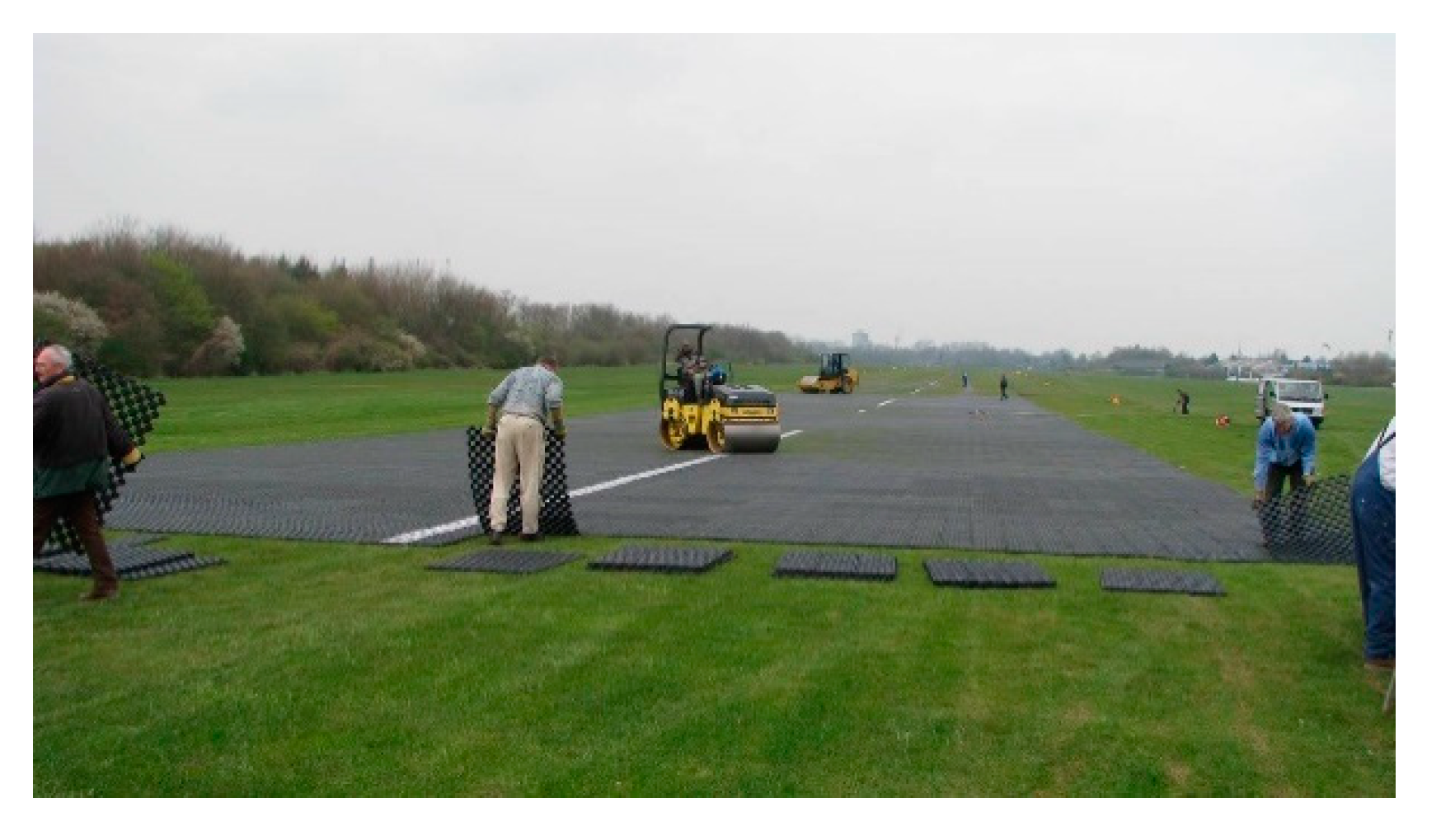
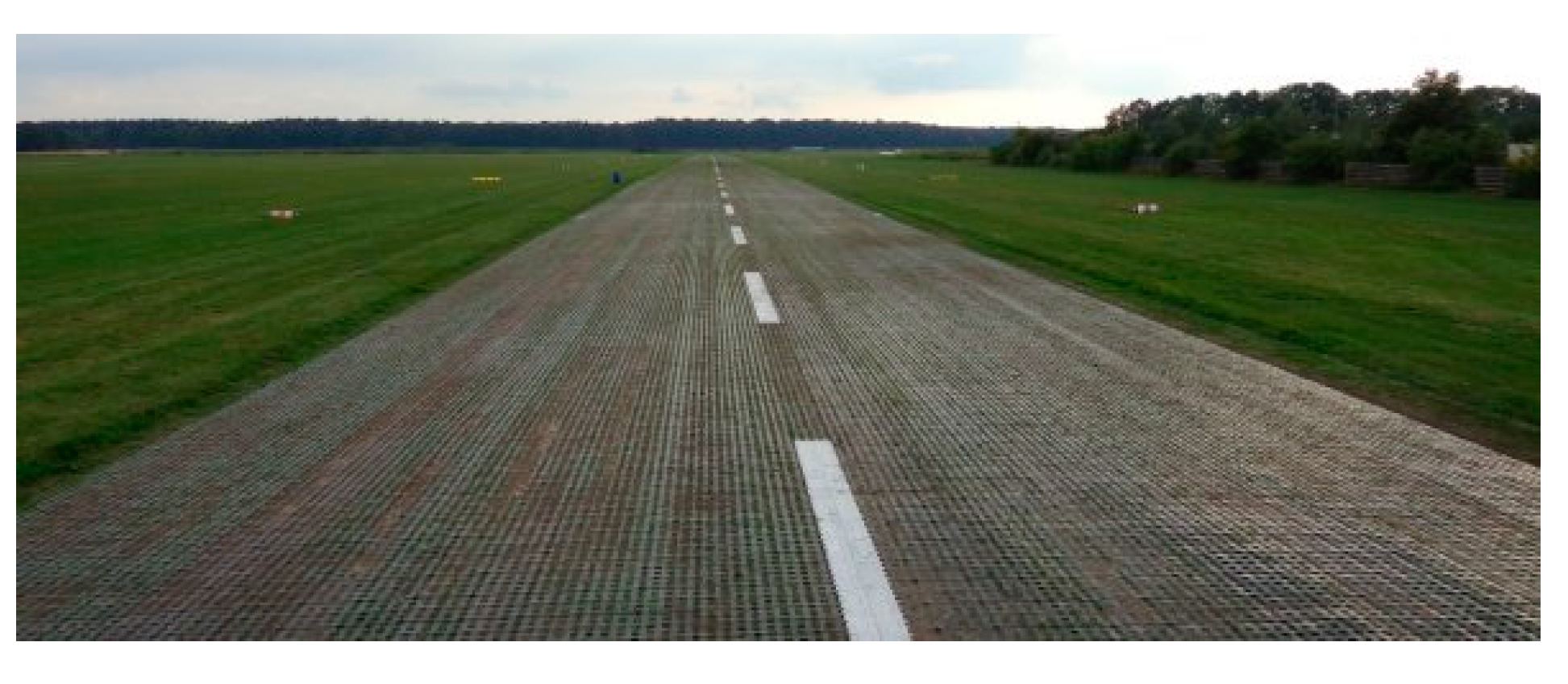


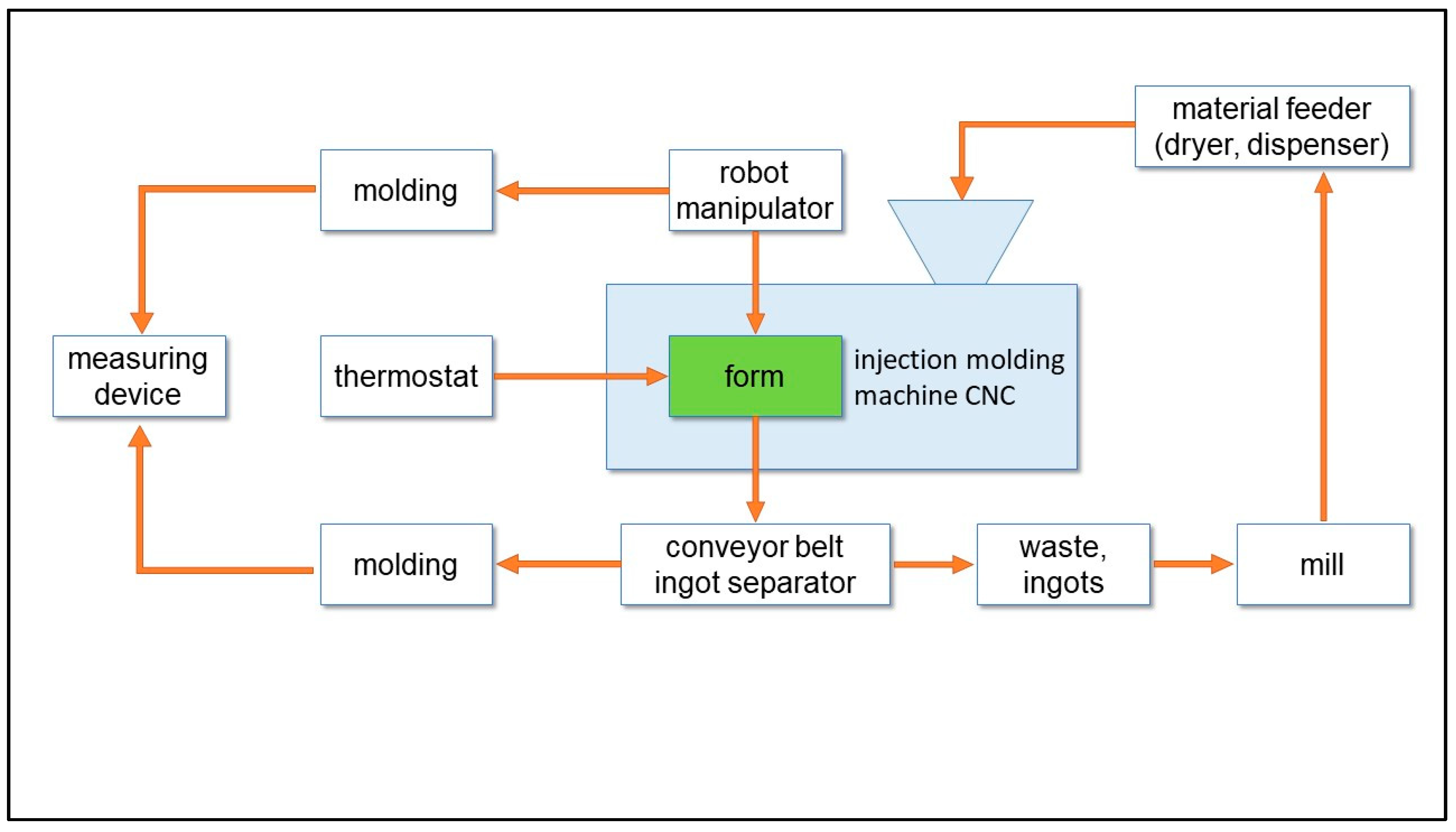
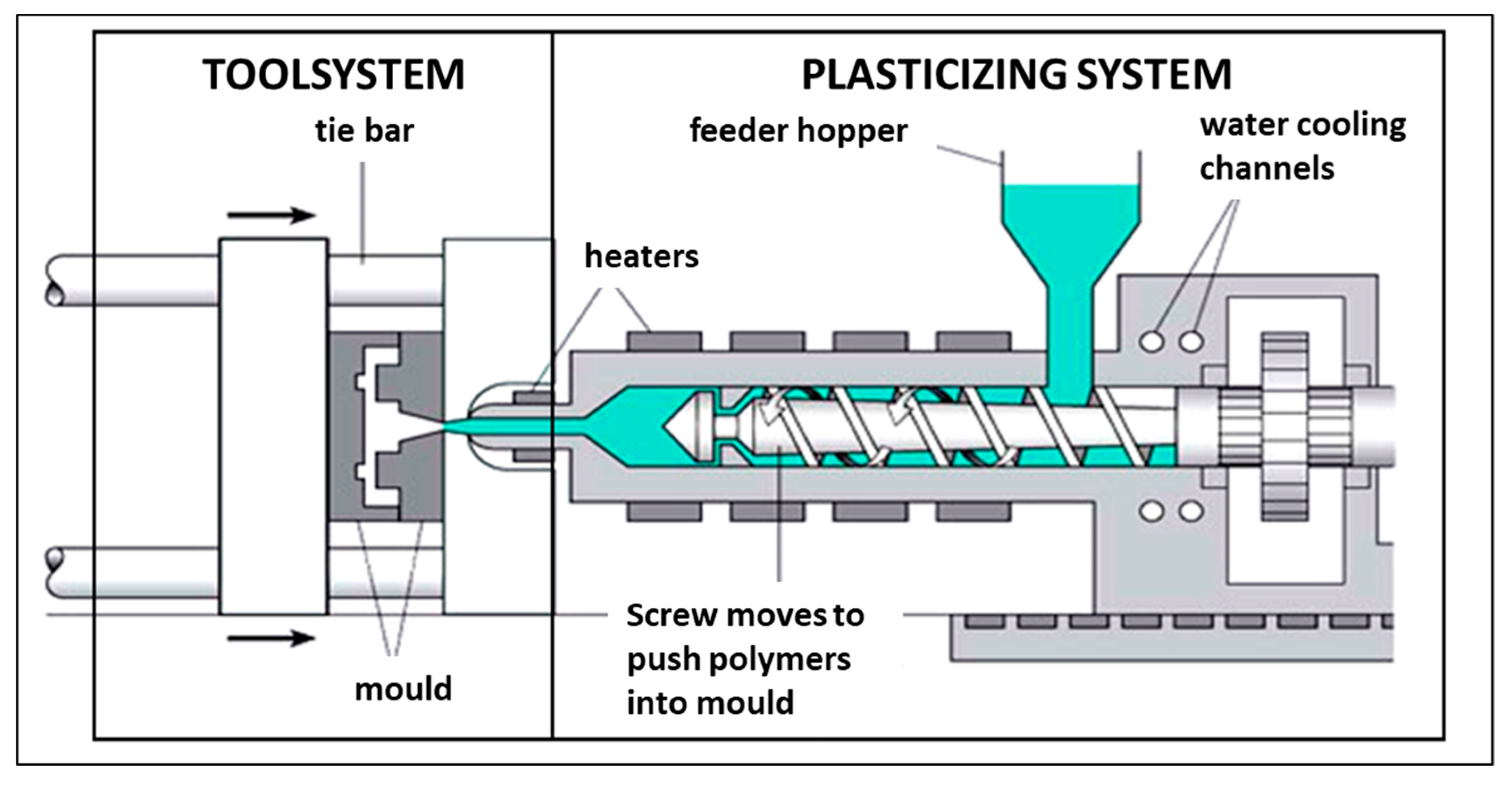

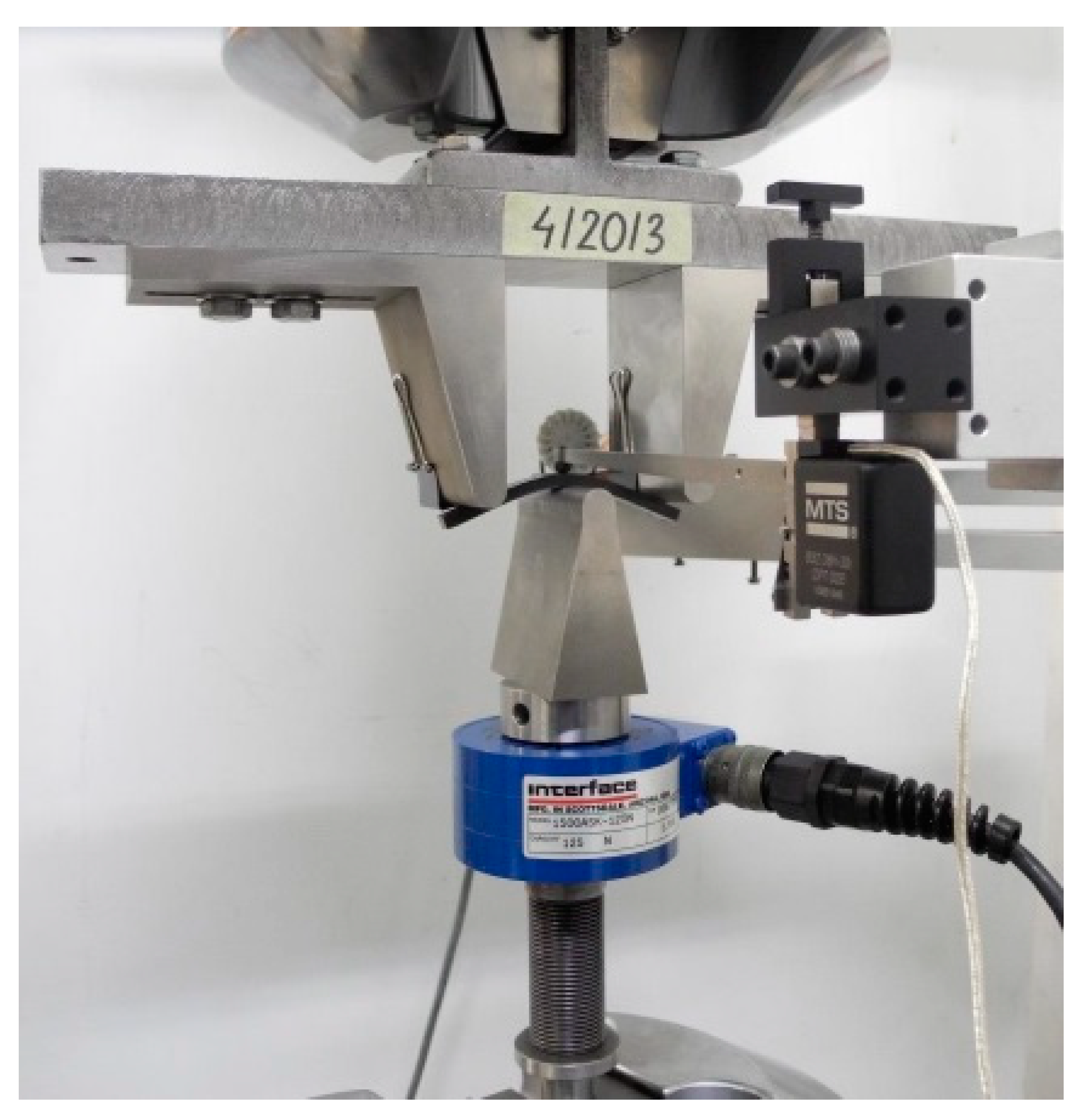
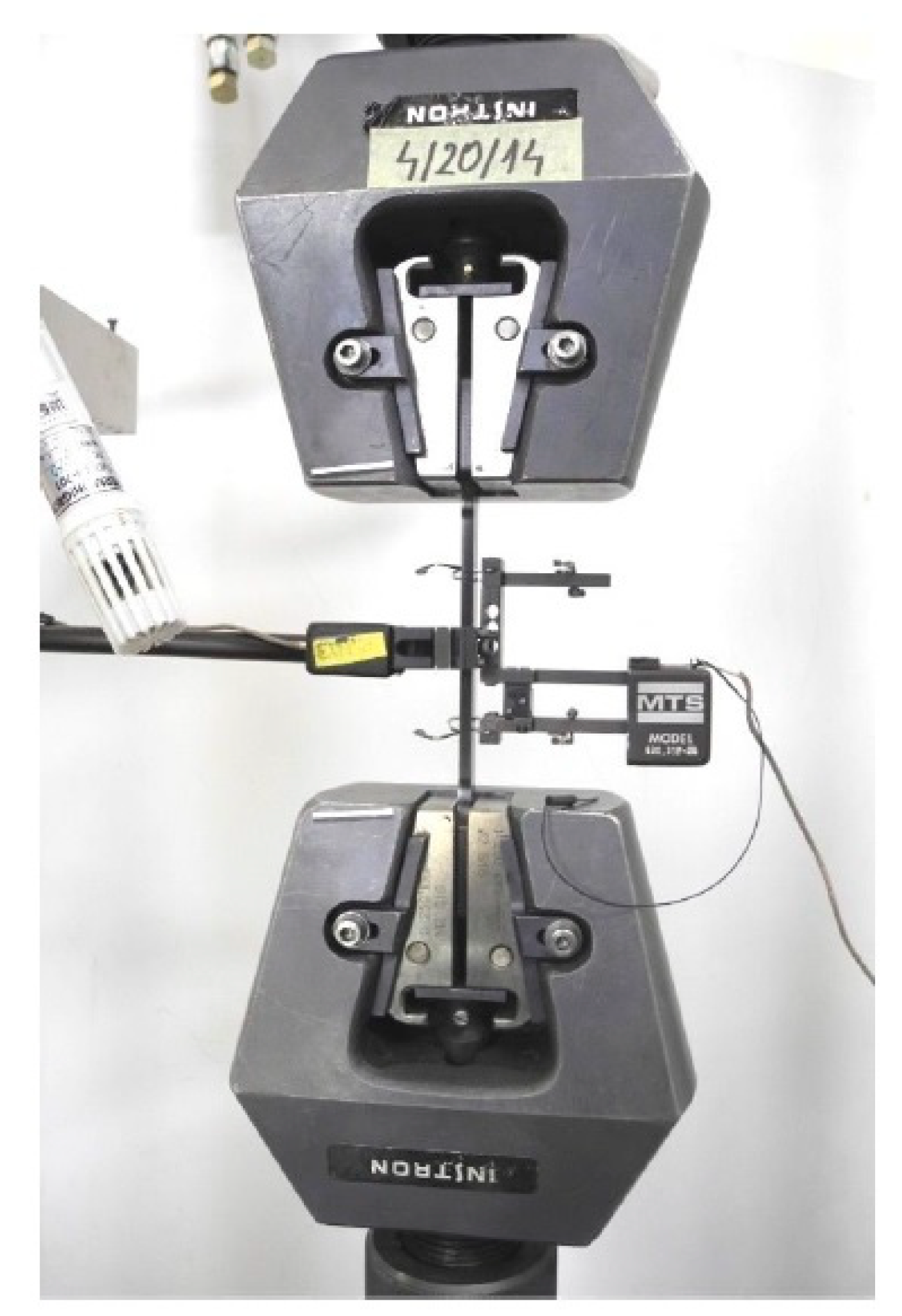
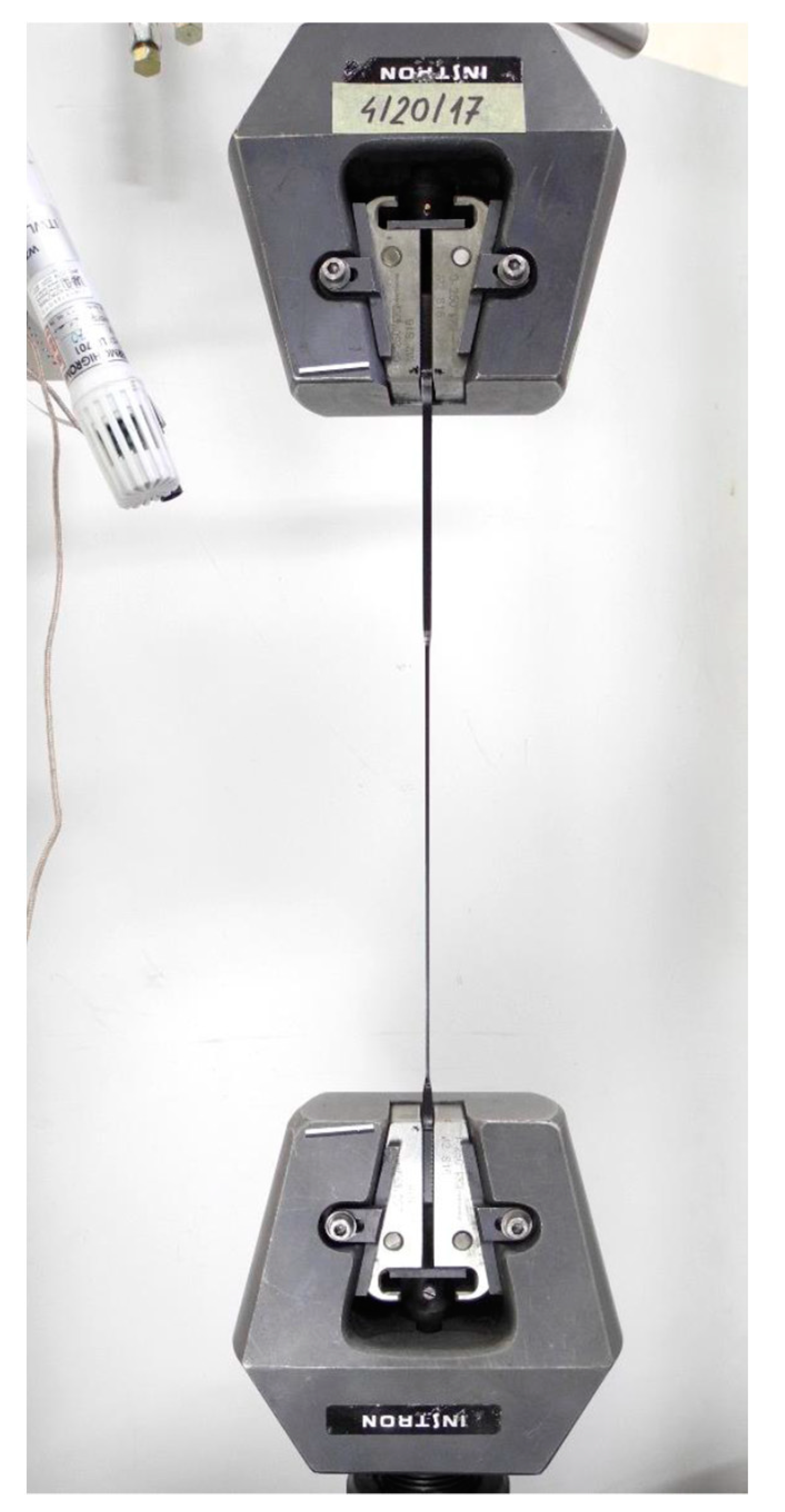
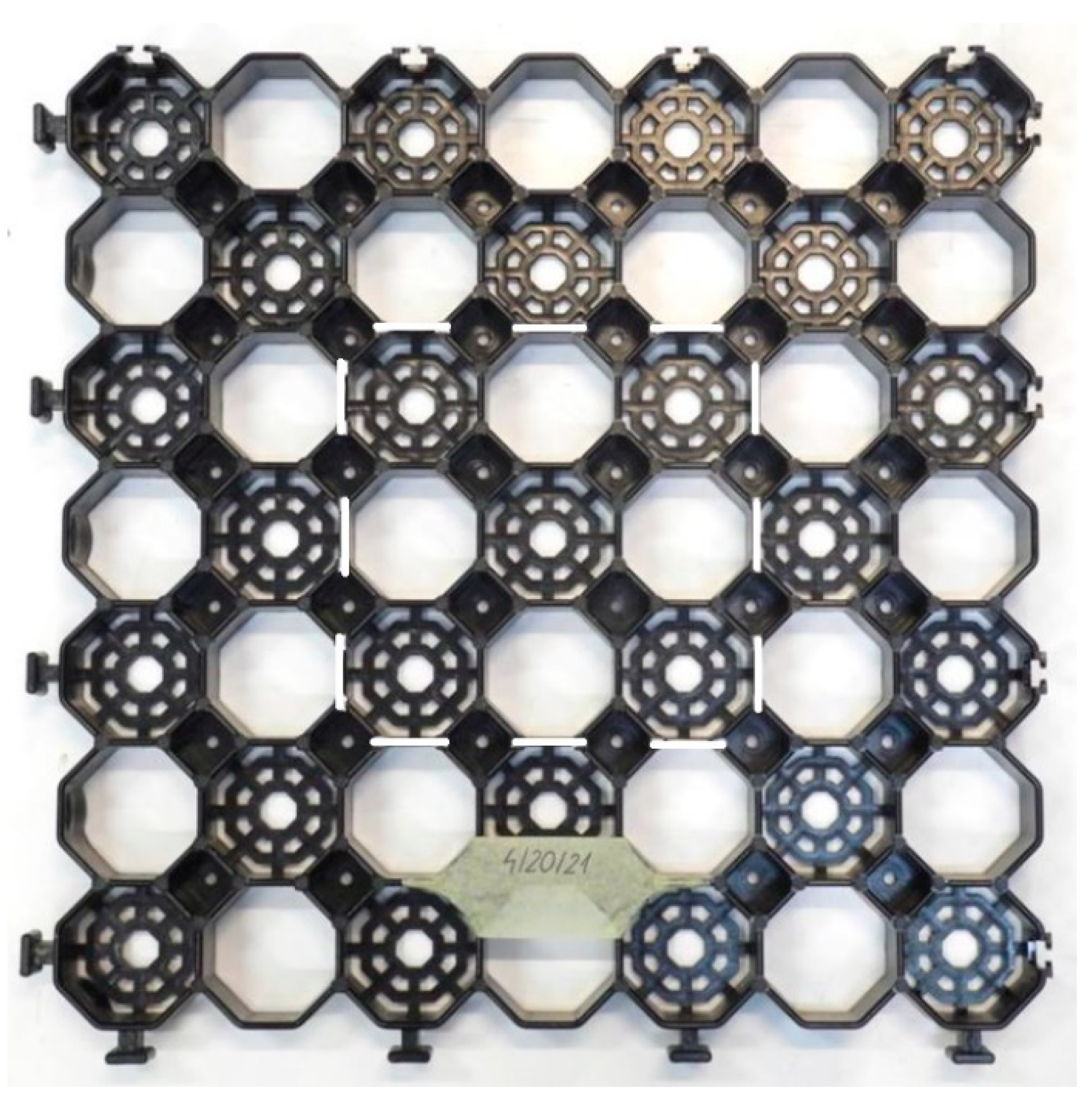

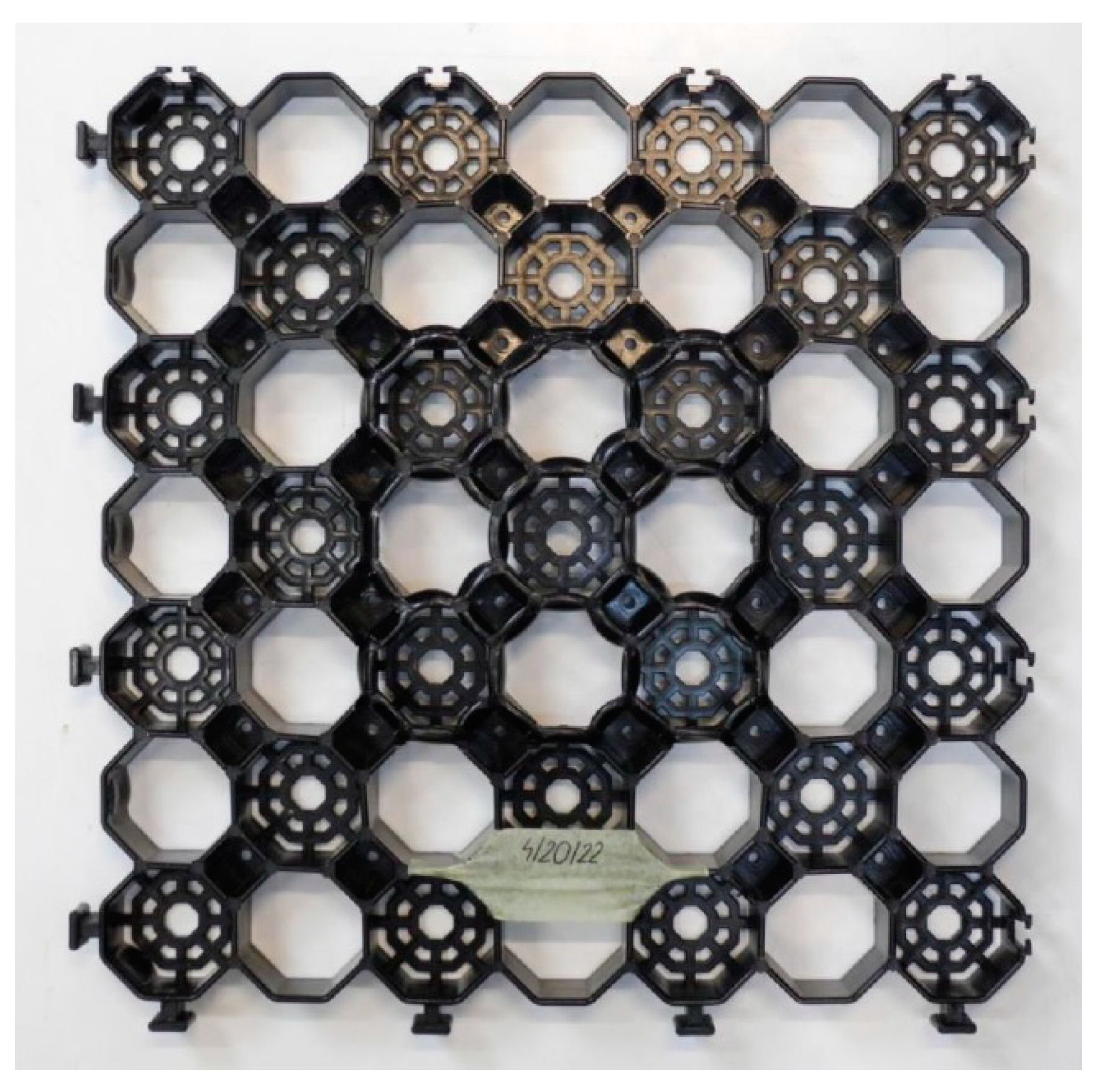
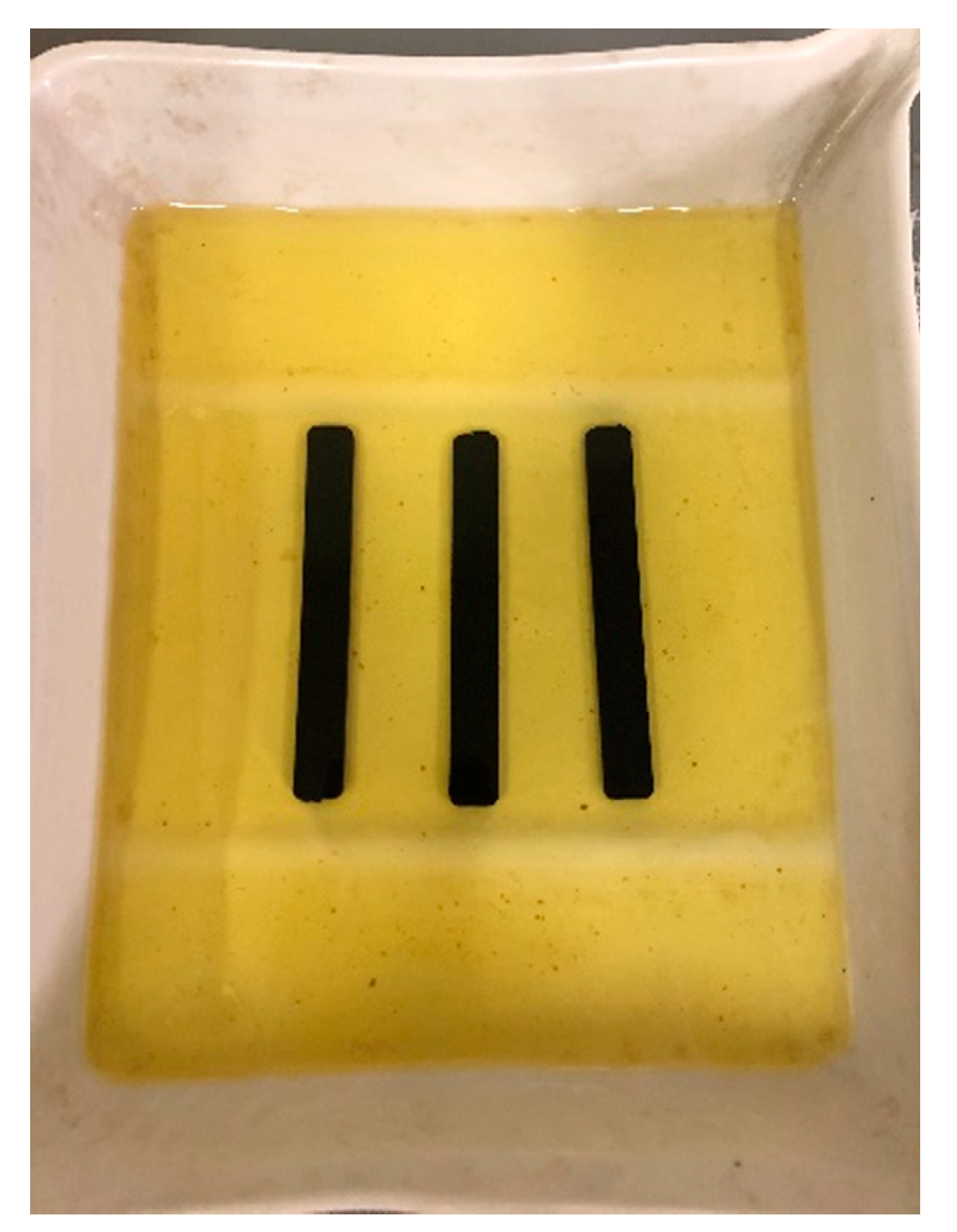

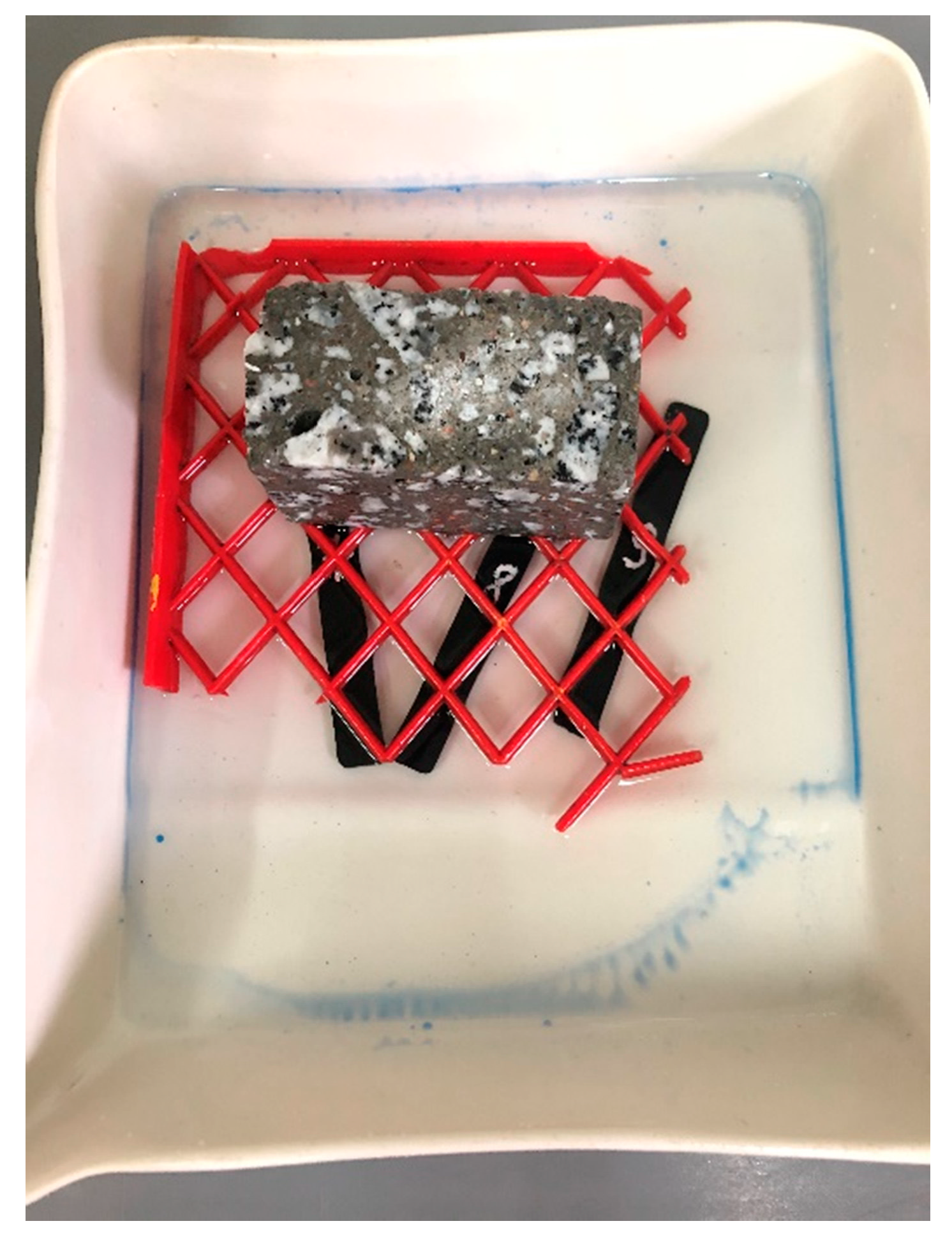
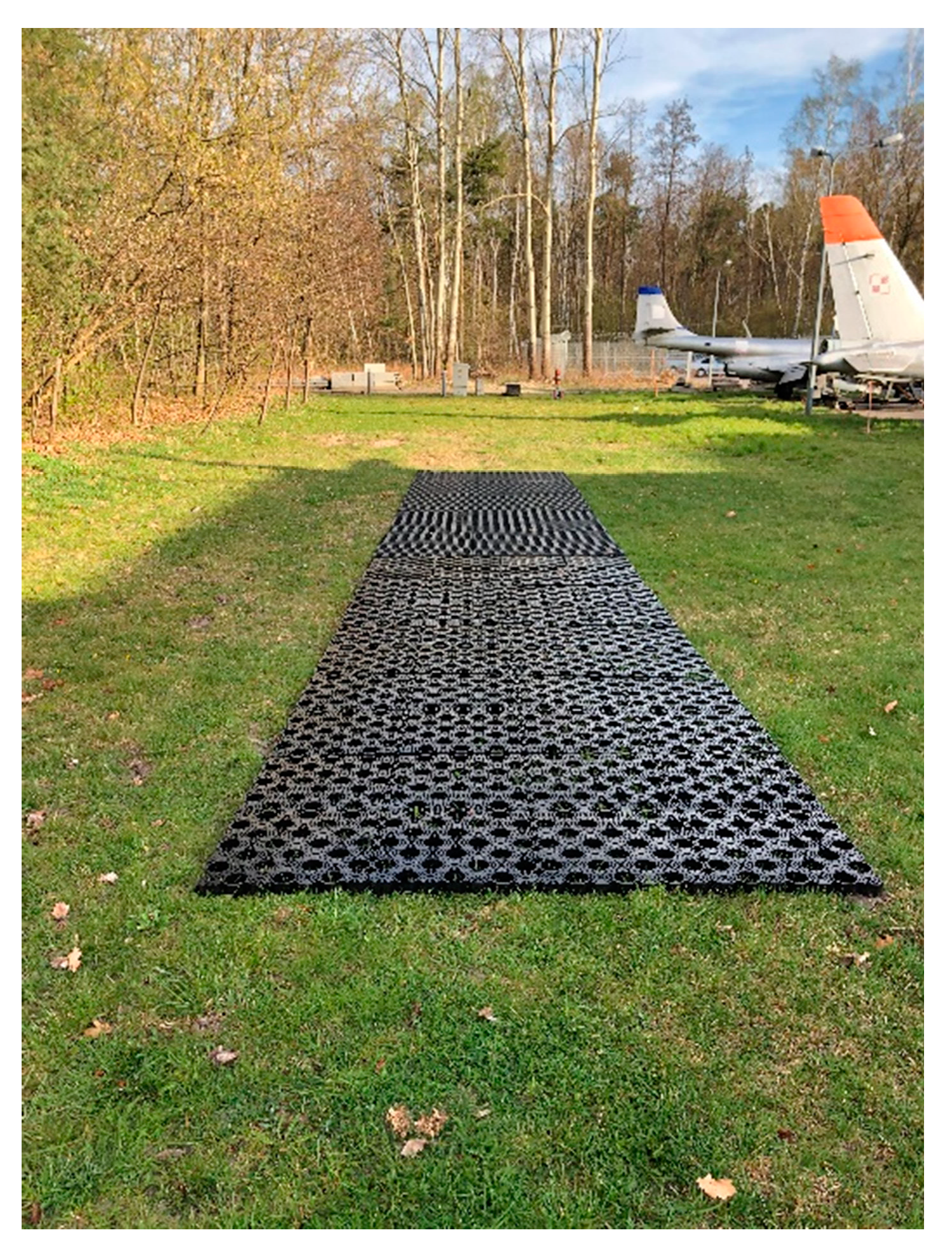
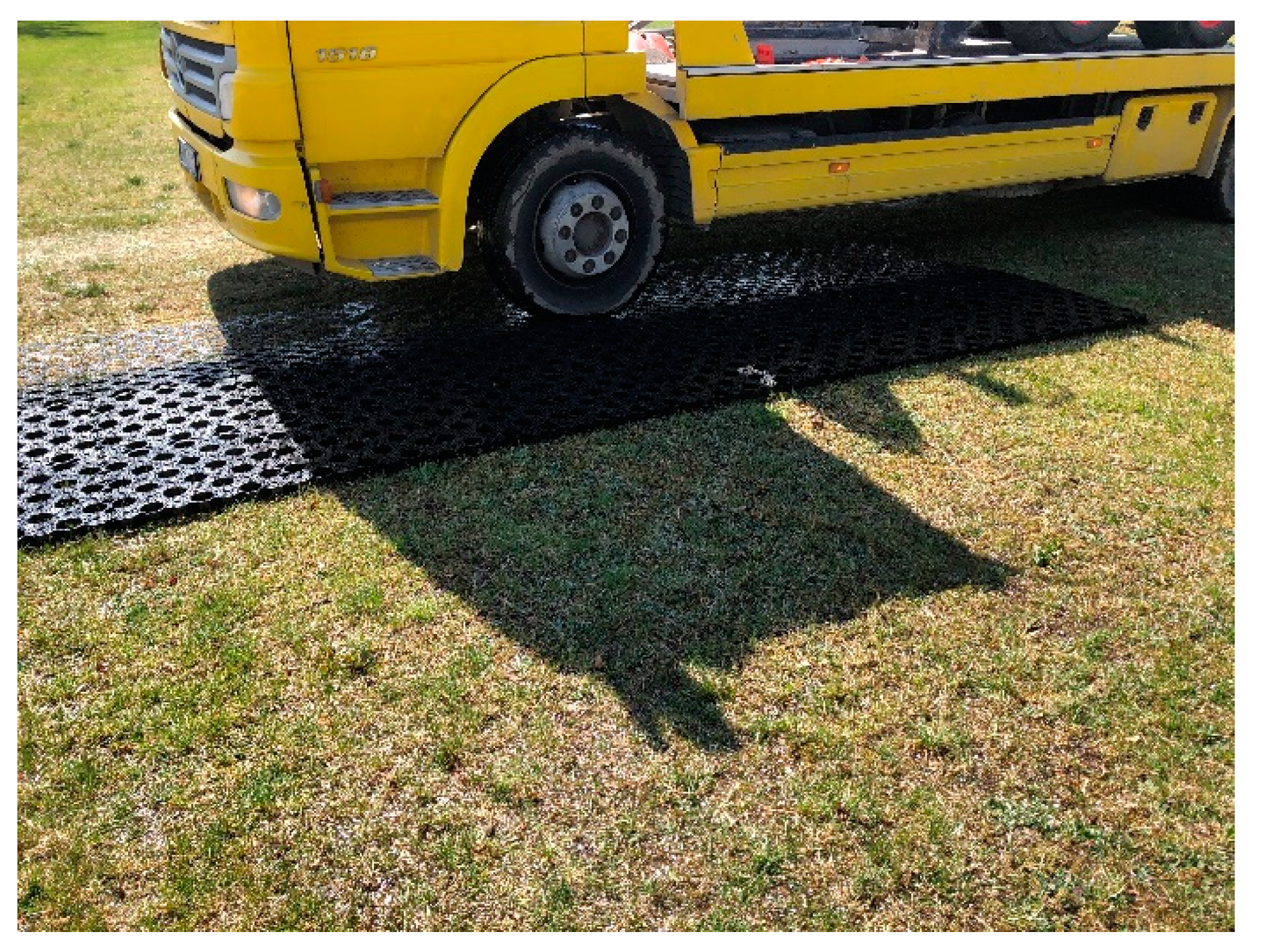


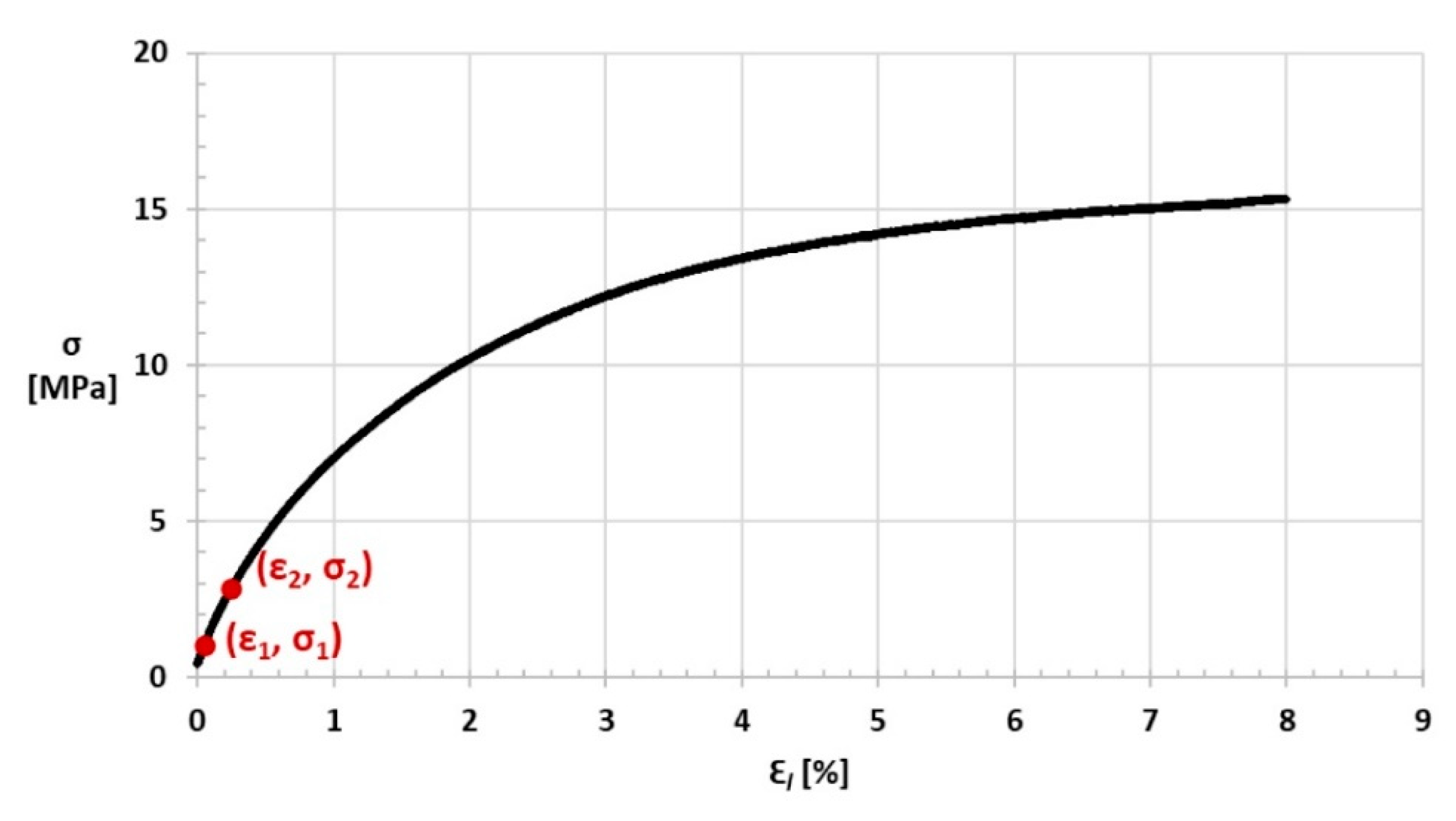
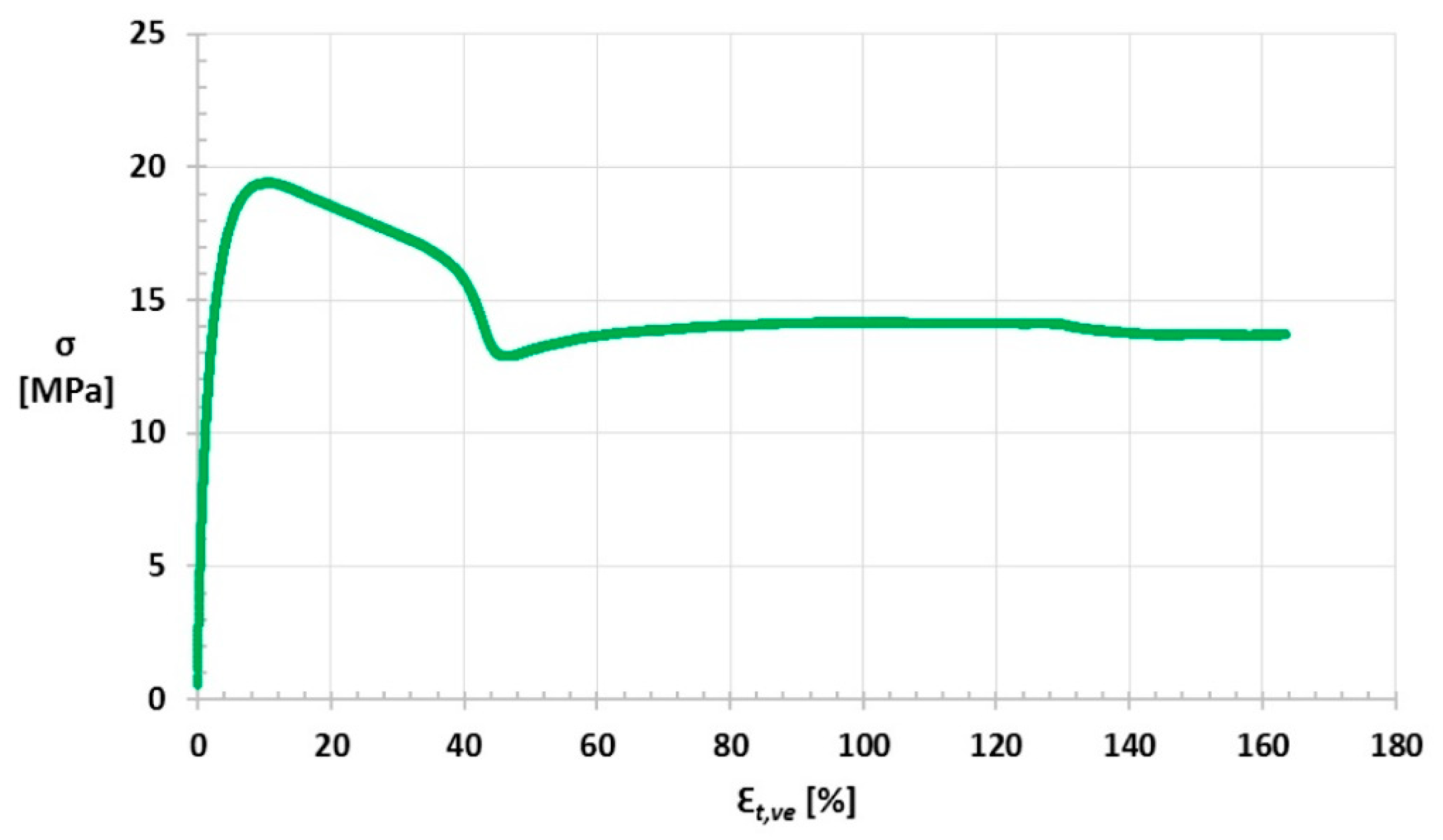
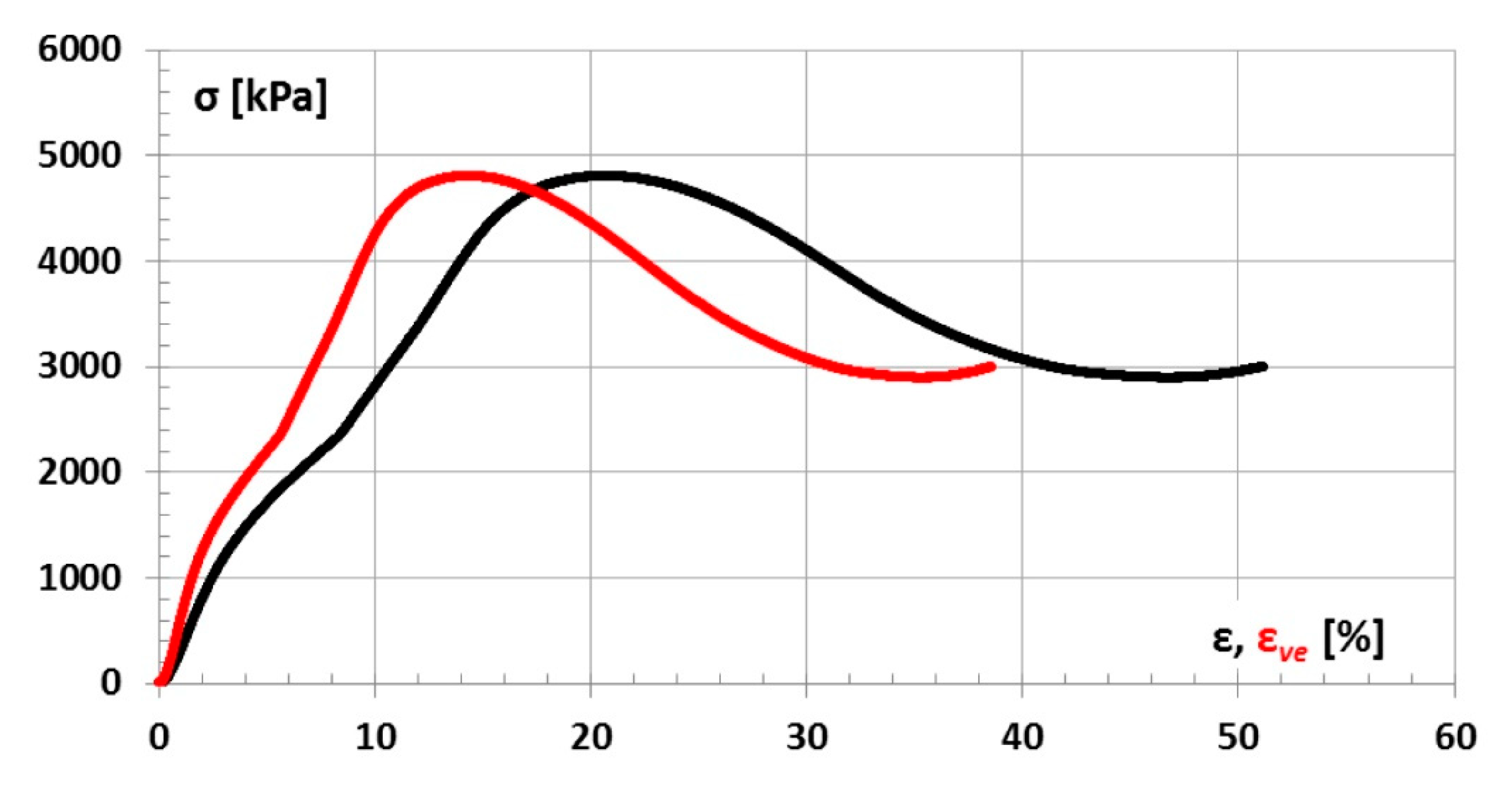

| Sample Number | σfC 1 [MPa] | σfCśr [MPa] | S(σfC) 2 [MPa] | mσfC 3 [MPa] | SC 4 [mm] | εfC 5 [%] |
|---|---|---|---|---|---|---|
| 1 | 17.6 | 17.5 | 0.14 | 17.4 < mσfC < 17.6 | 5.938 | 3.44 |
| 2 | 17.6 | 5.925 | 3.43 | |||
| 3 | 17.5 | 5.952 | 3.46 | |||
| 4 | 17.3 | 5.958 | 3.46 | |||
| 5 | 17.4 | 5.918 | 3.42 | |||
| 6 | 17.7 | 5.928 | 3.43 | |||
| 7 | 17.4 | 5.924 | 3.42 | |||
| 8 | 17.6 | 5.934 | 3.44 |
| Sample Number | Et 1 [MPa] | Et,śr [MPa] | S(Et) 2 [MPa] | mEt 3 [MPa] |
|---|---|---|---|---|
| 1 | 900 | 913 | 26.5 | 889 < mEt < 939 |
| 2 | 890 | |||
| 3 | 897 | |||
| 4 | 955 | |||
| 5 | 923 |
| Sample Number | μ 1 [-] | μśr [-] | S(μ) 2 [-] | mμ 3 [-] |
|---|---|---|---|---|
| 1 | 0.49 | 0.494 | 0.0 | 0.48 < mμ < 0.50 |
| 2 | 0.49 | |||
| 3 | 0.49 | |||
| 4 | 0.50 | |||
| 5 | 0.50 |
| Sample Number | σm 1 [MPa] | σm,śr [MPa] | S(σm) 2 [MPa] | mσm 3 [MPa] |
|---|---|---|---|---|
| 1 | 19.4 | 19.8 | 0.34 | 19.4 < mσm < 20.2 |
| 2 | 20.0 | |||
| 3 | 19.4 | |||
| 4 | 20.1 | |||
| 5 | 19.9 |
| Sample Number | εtm,ve 1 [%] | εtm,ve,śr [%] | S(εtm,ve) 2 [%] | mεtm,ve 3 [%] |
|---|---|---|---|---|
| 1 | 10.2 | 10.1 | 0.40 | 9.7 < mεtm.ve < 10.5 |
| 2 | 9.5 | |||
| 3 | 10.5 | |||
| 4 | 9.8 | |||
| 5 | 10.3 |
| Sample Number | σb’ 1 [MPa] | σb’,śr [MPa] | S(σb’) 2 [MPa] | mσb’ 3 [MPa] | εtb,ve’ 4 [%] |
|---|---|---|---|---|---|
| 1 | 14.1 | 14.2 | 0.29 | 13.9 < mσb’ < 14.5 | 160 |
| 2 | 14.4 | ||||
| 3 | 13.7 | ||||
| 4 | 14.4 | ||||
| 5 | 14.2 |
| Sample Number | σmr [kPa] | σmr,śr [kPa] | S(σmr) [kPa] |
|---|---|---|---|
| 1 | 4836 | 4811 | 27.9 |
| 2 | 4817 | ||
| 3 | 4781 | ||
| 1-1 | 4110 | - | |
| 1-2 | 3759 | ||
| 1-3 | 4082 | ||
| 1-4 | 4287 | ||
| Sample Number | εmr [%] | εmr,śr [%] | S(εmr) [%] |
|---|---|---|---|
| 1 | 20 | 20 | 0.6 |
| 2 | 21 | ||
| 3 | 20 | ||
| 1-1 | 19 | - | |
| 1-2 | 18 | ||
| 1-3 | 18 | ||
| 1-4 | 19 | ||
| Sample Number | εmr,ve [%] | εmr,ve,śr [%] | S(εmr,ve) [%] |
|---|---|---|---|
| 1 | 14 | 14 | 0.0 |
| 2 | 14 | ||
| 3 | 14 | ||
| 1-1 | 16 | - | |
| 1-2 | 16 | ||
| 1-3 | 15 | ||
| 1-4 | 16 | ||
| Medium | Sample Number | Weight before Soaking m [g] | Weight after Soaking m1 [g] | Weight Change [%] | Absorption Average Value [%] |
|---|---|---|---|---|---|
| Water | 1 | 2.935 | 2.938 | 0.003 | 0.14 s = 0.035 v = 25.3 |
| 2 | 2.913 | 2.918 | 0.005 | ||
| 3 | 2.919 | 2.923 | 0.004 | ||
| De-icing agent | 4 | 2.94 | 2.944 | 0.004 | 0.11 s = 0.039 v = 34.6 |
| 5 | 2.933 | 2.935 | 0.002 | ||
| 6 | 2.933 | 2.937 | 0.004 | ||
| Aviation fuel | 7 | 2.935 | 3.029 | 0.094 | 3.17 s = 0.038 v = 1.2 |
| 8 | 2.939 | 3.031 | 0.092 | ||
| 9 | 2.92 | 3.013 | 0.093 |
| Typical Properties | Nominal Value | Unit | Test Method |
|---|---|---|---|
| Flow rate indicator (MFR) 190 °C/2.16 kg 190 °C/5.0 kg | 4.0 11.0 | g/10 min g/10 min | ISO 1133-1 [40] |
| Density | 0.955 | g/cm3 | ISO 1183-1 [41] |
| Tensile flexibility modulus | 1200 | MPa | ISO 527-1, -2 [31,42] |
| Stress at the yield strength limit | 27 | MPa | ISO 527-1, -2 |
| Elongation at the yield strength | 8 | % | ISO 527-1, -2 |
| FNCT (3.5 MPa 2% Arkopal N100 80 °C) | 4.5 | h | ISO 16770 [43] |
| Toughness with notch according to Charpy’ego 23 °C, Type 1, karb A −30 °C, Type 1, karb A | 4.0 4.5 | kJ/m2 kJ/m2 | ISO 179 [44] |
| Shore Hardness (Shore D) | 60 | - | ISO 868 [45] |
| Ball hardness (H 132/30) | 52 | MPa | ISO 2039-1 [46] |
| Vicata softening temperature (B/50 N) | 73 | °C | ISO 306 [47] |
Publisher’s Note: MDPI stays neutral with regard to jurisdictional claims in published maps and institutional affiliations. |
© 2021 by the authors. Licensee MDPI, Basel, Switzerland. This article is an open access article distributed under the terms and conditions of the Creative Commons Attribution (CC BY) license (https://creativecommons.org/licenses/by/4.0/).
Share and Cite
Wesołowski, M.; Włodarski, P.; Iwanowski, P.; Kowalewska, A. Analysis and Assessment of the Usefulness of Recycled Plastic Materials for the Production of Airfield Geocell. Materials 2021, 14, 3557. https://doi.org/10.3390/ma14133557
Wesołowski M, Włodarski P, Iwanowski P, Kowalewska A. Analysis and Assessment of the Usefulness of Recycled Plastic Materials for the Production of Airfield Geocell. Materials. 2021; 14(13):3557. https://doi.org/10.3390/ma14133557
Chicago/Turabian StyleWesołowski, Mariusz, Piotr Włodarski, Paweł Iwanowski, and Agata Kowalewska. 2021. "Analysis and Assessment of the Usefulness of Recycled Plastic Materials for the Production of Airfield Geocell" Materials 14, no. 13: 3557. https://doi.org/10.3390/ma14133557
APA StyleWesołowski, M., Włodarski, P., Iwanowski, P., & Kowalewska, A. (2021). Analysis and Assessment of the Usefulness of Recycled Plastic Materials for the Production of Airfield Geocell. Materials, 14(13), 3557. https://doi.org/10.3390/ma14133557







